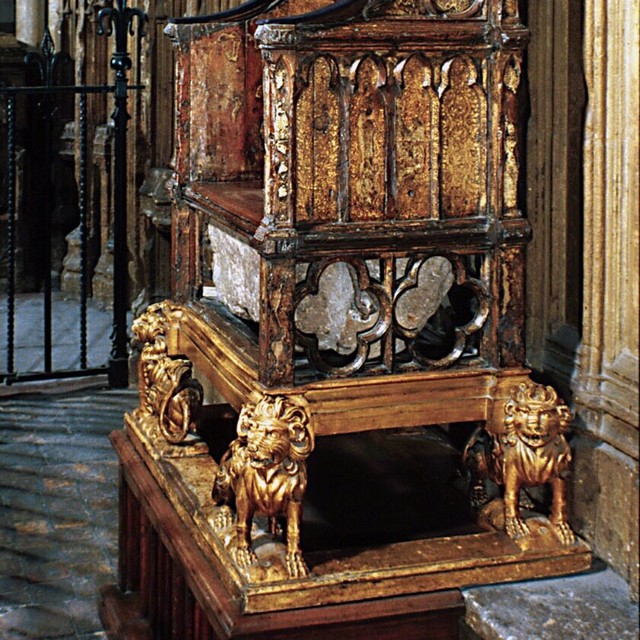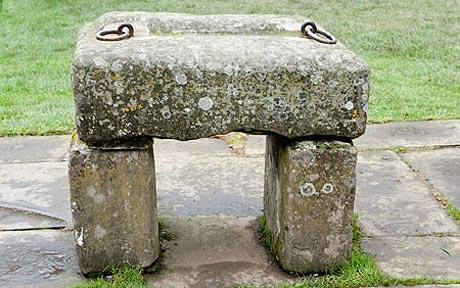The Stone of Scone — also known as the Stone of Destiny, and often referred to in England as The Coronation Stone—is an oblong block of red sandstone that was used for centuries in the coronation of the monarchs of Scotland, and later the monarchs of England and the Kingdom of Great Britain. Historically, the artefact was kept at the now-ruined Scone Abbey in Scone, near Perth, Scotland. It is also known as Jacob's Pillow Stone and the Tanist Stone, and in Scottish Gaelic, clach-na-cinneamhain. Its size is about 26 inches (660 mm) by 16.75 inches (425 mm) by 10.5 inches (270 mm) and its weight is approximately 336 pounds (152 kg). A roughly incised cross exists on one surface, and an iron ring at each end aids with transportation. The Stone of Scone was last used in 1953 for the coronation of Elizabeth II of the United Kingdom of Great Britain and Northern Ireland.
Stone of Scone has appeared in print, television and film media:
The Stone and its authenticity were the subject of the 1958 novel The Stone, by Scottish historical novelist Nigel Tranter. The Stone also appears in Tranter's novel Macbeth the King.
The Stone of Scone figures prominently in Das Königsprojekt, a 1974 novel by the German writer Carl Amery.
The return of the Stone of Scone to Scotland is documented in the Scottish Gaelic song "Òran na Cloiche" ("Song of the Stone"), covered by artists such as Kathleen MacInnes and Mànran.
In the episode "Pendragon", of the Gargoyles television series, King Arthur arrives in London and encounters the Stone of Destiny at Westminster Abbey. The Stone tells Arthur that he must prove himself once more worthy of Excalibur, and sends him and his "squire"—the London Clan gargoyle Griff—to New York to complete the task. The story is expanded in the follow-up Gargoyles SLG comics.
In 1996 Trilobyte released the game Clandestiny, in which the ultimate goal is to find the Stone of Scone and return it to its proper place.
In the two-part series finale of the Hamish Macbeth TV series, which aired in 1997, a millionaire is searching for the real Stone, as the one in Westminster Abbey is a fake. Hamish (Robert Carlyle) leads a posse on a trek to rescue their friend and save the Stone.
In a 1997 episode of the television series Highlander, the 1950 return was adapted, with the characters Duncan MacLeod (Adrian Paul), Hugh Fitzcairn (Roger Daltrey) and Amanda Darieux (Elizabeth Gracen) stealing the stone for various reasons.
Terry Pratchett's 1999 Discworld novel, The Fifth Elephant, is centred around the theft of a Dwarfish coronation seat, which is made from hardened bread and called the Scone of Stone.
In Patricia Kennealy Morrison's science-fantasy series The Keltiad, the 1986 novel The Throne of Scone describes a stone that has been transmuted into a throne.
The Stone is referred to in Derek Webb's comedy play Bringing Back the Bluestones, in which a Welsh group decide to emulate the return of the Stone of Scone to Scotland by demanding the return of the Bluestones from Stonehenge to Pembrokeshire.
The 2005 Doctor Who short story "Set in Stone" features the Doctor, Ian Chesterton, and Barbara Wright stealing the stone.
In 2000, a bilingual BBC film (English and Scottish Gaelic) Interrogation of a Highand Lass/An Ceasnachadh was released. The plot is about the 1950 liberation of the stone from Westminster Abbey, in which Matheson is played by Kathleen MacInnes.
In October 2008, a feature film called Stone of Destiny, based on the theft of the Stone, was released. The film was written and directed by Charles Martin Smith, and produced by Rob Merilees and William Vince. The role of the Scottish nationalist politician John MacCormick was played by Robert Carlyle.
In the 2010 film The King's Speech, Australian speech therapist Lionel Logue sits on the coronation throne to provoke King George VI into talking. In the ensuing argument, the king refers to the Stone of Scone.
The 2011 Jeanette Baker novel Legacy is a fictional account of the original Stone of Scone being hidden, while a replica is taken to Westminster Abbey.
In one adventure of Solar Pons, the Sherlock Holmes pastiche created by August Derleth, a Scottish nationalist steals the Stone from Westminster Abbey in 1935. The fictional event was first published in "The Return of Solar Pons" in 1958.














